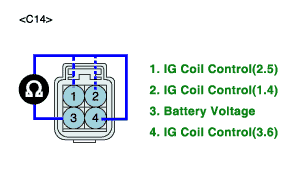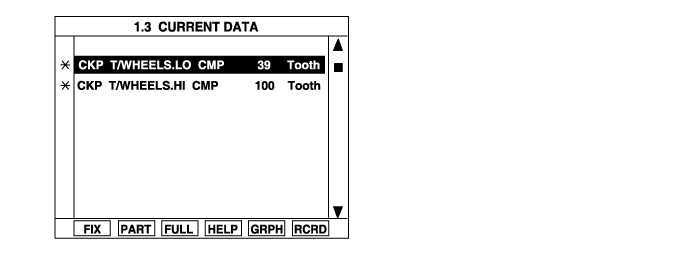Measure the resistance in each primary coil, referring to specification.(Component side).
Specification : Approx. 0.96 ± 10% (Ω) at 20°C(68°C)No.1 & 4 cyl. : terminals 3& 2No.2 & 5 cyl. : terminals 3& 1No.3 & 6 cyl. : terminals 3& 4

Remove suspect cylinder`s spark plug cable.
Visually/physically inspect the following items:
Damage, crack and flashover
Measure the resistance of the spark plug cable referring to specification.
Specification :
SPARK PLUG INSPECTION | |||||
N0.1 | No.2 | No.3 | No.4 | No.5 | No.6 |
4.39~6.59 | 2.28~3.43 | 3.49~5.24 | 1.9~2.86 | 3.25~4.87 | 1.3~1.95 |
Resistance should not be higher than 10,000Ω per foot of cable. If resistance is higher than specification, replace the cable.
Is resistance within the specification?
YES
▶ Go to "Spark Plug Inspection " procedure.
NO
▶ Repair as necessary and go to "Verification of Vehicle Repair" procedure.
Remove suspect cylinder`s spark plugs.
Visually/physically inspect the following items:
Damaged insulation, Worn electrodes, Oil or fuel fouled, Loose terminals and cracks.
Check for plug gap : 1.0 - 1.1 mm (0.039 - 0.043 in.).
Check if the spark plug for the relevant cylinder is lighter in color than the other plugs.
Was a problem found in any of the above areas?
YES
▶ Repair as necessary and go to "Verification of Vehicle Repair" procedure.
NO
▶ Go to "Fuel Injector Inspection" procedure.
Check the fuel injectors for clogging or any restrictions.
Test Condition : Ignition "OFF"Specification : No clogging and restriction
Is the fuel injector OK?
YES
▶ Visually/physically inspect the engine mechanical problem as below:
Bent push rods
Leaky or sticky valves or rings
Excessive valve deposits
Weak valve spring
Leaking head gasket
If NG, repair as necessary and go to "Verification of Vehicle Repair" procedure.
If OK, go to "Ignition Coil Inspection" procedure.
NO
▶ Repair as necessary and go to "Verification of Vehicle Repair" procedure.
Ignition "OFF"
Disconnect ignition coil connector
Visually/physically inspect the following items:
Damage, cracks and flashover.
Measure the resistance in each primary coil, referring to specification.(Component side).
Specification : Approx. 0.96 ± 10% (Ω) at 20°C(68°C)No.1 & 4 cyl. : terminals 3& 2No.2 & 5 cyl. : terminals 3& 1No.3 & 6 cyl. : terminals 3& 4

Is resistance within the specification?
YES
▶ Go to "Timing Inspection" procedure.
NO
▶ Test with a new ignition coil and check for proper operation. If problem is corrected, replace ignition coil and go to "Verification of Vehicle Repair" procedure.
Start engine and let vehicle idle
Connect scantool and select "Current Data" mode
Monitor "CKP T/WHEELS-LO CMP" & "CKP T/WHEELS-HI CMP" parameters on the Scantool data list.
Specification :"CKP T/WHEELS-LO CMP" : 38 +/- 4 tooth "CKP T/WHEELS-HI CMP" : 98 +/- 4 tooth

Are "CKP T/WHEELS-LO CMP" & "CKP T/WHEELS-HI CMP" parameters within the specification?
YES
▶ Go to " Air Leakage Inspection " procedure.
NO
▶ Remove Crankshaft Position Sensor(CKPS) and calculate air gap between sensor and flywheel/torque converter. Readjust as necessary and go to next step.
Air gap [0.3~1.7 mm [0.012~0.067 in] = measure distance from housing to teeth on flywheel/torque converter (measurement "A") and from mounting surface on sensor to sensor tip (measurement "B") subtract "B" from "A"
If fail to synchronize CKPS with CMPS, check that the crankshaft and camshaft are correctly aligned the matching marks of the pulleys. Repair or readjust as necessary and go to "Verification of Vehicle Repair" procedure.
Visually/physically inspect the air leakage in intake/exhaust system as following items,
If OK, go to next step
If NG, repair as necessary and go to "Verification of Vehicle Repair" procedure.
Vacuum hoses for splits, kinks and improper connections.
Throttle body gasket
Gasket between intake manifold and cylinder head
Seals between intake manifold and fuel injectors
Exhaust system between HO2S and Three way catalyst for air leakage
Was a problem found in any of the above areas?
YES
▶ Go to "Fuel System Inspection" procedure
NO
▶ Repair air leakage and go to "Verification of Vehicle Repair" procedure.
Check the fuel for excessive water, alcohol, or other contaminants. Replace contaminated fuel as necessary.
Install a fuel pressure gage.
Start engine and let it idle. Inspect fuel pressure with vacuum hose disconnected.
Test Condition : Engine "ON" at IdleSpecification : 330~350kPa(3.30~3.50 kg/㎠, 47~50 psi)
Is fuel pressure within the specification?
YES
▶ Check for poor connection between ECM and component: backed out terminal, improper mating, broken locks or poor terminal to wire connection. Repair as necessary and go to "Verification of Vehicle Repair" procedure
NO
▶ Repair as necessary refer to inspection noted as below and go to "Verification of Vehicle Repair" procedure
Check if fuel line pressure decreases when accelerating quickly.
If it does, check fuel pump maximum pressure. If pressure is OK, check fuel line and filter for clogging.
If fuel pressure is lower than specification : Check for fuel line pressure while pinching fuel return hose.
If pressure quickly increases, check pressure regulator
If pressure gradually increases, check for clogging between fuel pump and pressure regulator. If hose is not clogged, check fuel pump maximum pressure.
If fuel pressure is higher than specification : Is fuel line clogged?
If it is not, replace pressure regulator.
If it is, replace it.